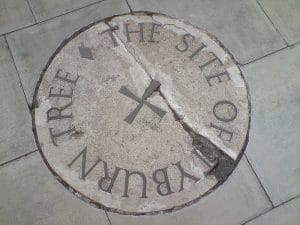 On 10th December 1541, just a month and eight days after an investigation into Queen Catherine Howard’s past was ordered, two men were executed at Tyburn. They were Thomas Culpeper, a gentleman of the privy chamber, and Francis Dereham, a member of the queen’s household.
On 10th December 1541, just a month and eight days after an investigation into Queen Catherine Howard’s past was ordered, two men were executed at Tyburn. They were Thomas Culpeper, a gentleman of the privy chamber, and Francis Dereham, a member of the queen’s household.
Both men had been tried for treason at Guildhall on 1st December 1541 “for high treason against the Kinges Majestie in mysdemeanor with the Quene”. Neither man was accused of actually committing adultery with the queen, the trial focused on their intentions. By meeting secretly with the queen on the recent royal progress, Culpeper and the queen were ‘inciting’ each other to have “carnal intercourse”, and Dereham joining the queen’s household, having previous had a sexual relationship with her, was seen as evidence that he wanted to reignite their relationship. They were both found guilty of high treason and sentenced to be hanged, drawn and quartered
Culpeper and Dereham were drawn on hurdles from the Tower of London to Tyburn on 10th December 1541. Chronicler and Windsor Herald Charles Wriothesley writes “and there Culpeper, after exhortation made to the people to pray for him, he standinge on the ground by the gallowes, kneled downe and had his head stryken of.” Culpeper’s sentence had been commuted to beheading, due to his status, a more merciful death than that of his companion, Dereham, who “was hanged, membred, bowelled, headed, and quartered.” Their heads were then displayed on London Bridge and Dereham’s quartered remains were displayed around the city. Culpeper’s body was taken to St Sepulchre-without-Newgate Church and laid to rest there.
You can read more details in my previous article.
Source: Wriothesley, Charles (1875) A chronicle of England during the reigns of the Tudors, from A.D. 1485 to 155, p. 131-132.
Picture: Picture: Stone marking the site of the Tyburn Tree, i.e. the gallows, on the traffic island at the junction of Edgware Road, Bayswater Road and Oxford Street (Wikipedia).